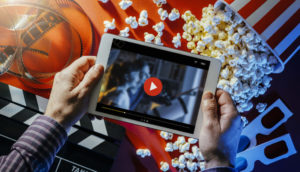Exclusives

Three Capabilities Streaming Services Need to Capitalize on New Consumer Behaviors
Story Highlights
Consumer media consumption behavior has changed irrevocably during the COVID-19 pandemic: OTT platforms experienced a 17% increase in the number of viewing households this year, and 25% of television viewing is now coming from streaming platforms — a significant shift that’s disrupting industry business models.
These changes in consumer behavior are here to stay. While some behaviors, such as visiting theme parks and movie theaters, will return post-pandemic, consumers who have adapted to the convenience and personalization of digital channels on an everyday basis won’t go back to “normal.” Recent research by PK, compiled in the 2020 Media Digital Experience Index study, confirms this.
As a result, the already fierce fight for streaming subscribership is growing even fiercer, and continuing the standout success of these services will require media and entertainment (M&E) leaders to double down on several key technology capabilities that can transform how their companies build customer loyalty and retain subscribers.
 Streaming services are already evolving — but not far enough
Streaming services are already evolving — but not far enough
We’re already seeing M&E companies adapt to these market changes: Where once they relied on a mix of movie theater and cable distribution, licensing, in-person experiences and digital, they’re now shifting business planning and operations to focus primarily on vertically integrated digital channels and direct-to-consumer (D2C) streaming models.
Both Warner Media and The Walt Disney Company have recently announced major internal reorganizations to focus content development on vertically integrated channels like Disney+, HBOMax, Peacock and Hulu, and HBOMax recently announced its first advertiser supported channel in addition to its subscription service.
We’re also are seeing a noticeable shift in marketing as traditional studios, which are experts at creating events and maximizing the entertainment value of content, begin in earnest to build streaming subscribership. Peacock, for example, leveraged NBCUniversal’s paid TV distributors to market the platform’s launch.
In addition, Netflix aggressively marketed its holiday “movie a day” campaign, in which it launched a new movie almost every day in December – indicating future tactics that will be employed industry-wide. Expect to see the marketing wars around streaming platforms heat up as industry players aim to increase market share, engagement and retention. Don’t be surprised when third-party tie-ins like the Peacock/Comcast and Disney+/Verizon partnerships begin cropping up across other product categories.
While these reorganizations and new marketing efforts are a critical first step, there are clear signs that more change will be needed. Research conducted by PK found that 62% of consumers have signed up for a streaming service with the intent to cancel after viewing a specific show, which suggests that content alone isn’t enough to retain subscribers.
Instead, consumers will begin looking to other offerings, such as transmedia (including games and merchandise that extend the viewing experience), personalization and features like chat and social media integration when they consider which platforms are worthy of renewal.
As the battle to provide more innovative streaming experiences heats up, those who have the scale and efficiency to be first to the table with “must-have” offerings and better serve customers will come out on top. Doing so, however, will require M&E companies to adapt new capabilities that tap into the promise of streaming services’ rapid growth this year.
Intelligent automation can increase business agility and enable scale
As M&E companies seek to enhance their digital offerings, it will be critical to ensure that employees are focused on developing products and features that drive customer engagement. M&E leaders must transform their companies’ ways of working to create the right environment for innovation.
 Elements of intelligent automation such as robotic process automation (RPA) will play an essential role in enabling the efficiency and agility needed to step into a new age of streaming. RPA, which uses bots (or digital workers), can automate much of the heavy lifting of the manual work that takes up so much of employees’ time on a day-to-day basis – such as device activation, forms and license processing, customer data management and metadata updates.
Elements of intelligent automation such as robotic process automation (RPA) will play an essential role in enabling the efficiency and agility needed to step into a new age of streaming. RPA, which uses bots (or digital workers), can automate much of the heavy lifting of the manual work that takes up so much of employees’ time on a day-to-day basis – such as device activation, forms and license processing, customer data management and metadata updates.
Adopting intelligent automation creates efficiencies that enable employees to focus on higher value activities, which kickstarts a cultural transformation by centering work on ideation, critical analysis and forward thinking instead of everyday administrative tasks.
APIs can streamline and secure data-sharing
The M&E industry has experienced record consolidation in recent years, including ATT’s purchase of Time Warner, Disney’s purchase of 21st Century Fox and Comcast’s acquisition of Sky Media.
Each acquisition comes with the challenge of integrating new subsidiaries into technology stacks that already utilize a multitude of platforms and systems. And the need for interoperability is high in streaming, as it’s essential to delivering content and new platform offerings seamlessly.
Otherwise, streaming services may experience content fragmentation, with new shows are siloed to individual platforms or device types. Extending streaming platforms to new capabilities beyond content will only add additional complexity to an already hodgepodge technology environment – and this challenge is one that APIs are uniquely poised to solve.
APIs stand to have an outsized impact on M&E companies facing mounting complexity, as this technology streamlines and secures data-sharing across platforms and business units. This enables collaboration, insight and agility where there were once disparate, dysfunctional systems that slowed the pace of innovation.
 Personalization and analytics enable robust customer relationships
Personalization and analytics enable robust customer relationships
While personalization of content recommendations has become the norm in recent years, most brands have a long way to go. Our research found that only three companies received high scores for personalization on their platforms: Netflix, TVision and HBO Max. And that’s a major problem; 73% of subscribers say they will only engage with personalized messaging, and 63% will stop buying from brands that use poor personalization tactics.
Improving personalization starts with better analytics that enable M&E companies to fine-tune their audience understanding and predict content customers want from their streaming platforms.
In the coming year, M&E companies must look to strengthen their analytics capabilities through real-time analysis that enables rapid understanding, action and iteration. There’s also an opportunity to push personalization into new areas with more powerful analytics – we found there is a whitespace for personalization off-platform, such as on social media or in email communications.
Today’s M&E landscape is continuously evolving and is likely to continue doing so for years to come. Tomorrow’s market leaders will be the ones who’ve laid the technology groundwork for future bets today and who continually seek to improve both their content offerings and engagement with their platforms. To learn more about what customers want from streaming services today and see how top platforms compare, read our 2020 Media Digital Experience Index survey.
* By Jeffrey Thompson, VP, Client Partner, PK
Jeffrey Thompson co-leads the media and entertainment practice at PK, the experience-led engineering company. He has more than 20 years of experience driving digital innovation with leading studios and global media enterprises including Disney, Conde Nast Entertainment, Shout! Factory and more. Jeffrey brings a wealth of expertise in M&E, particularly around digital transformation and evolving business models.









